Erasure coding, a new feature in HDFS, can reduce storage overhead by approximately 50% compared to replication while maintaining the same durability guarantees. This post explains how it works.
HDFS by default replicates each block three times. Replication provides a simple and robust form of redundancy to shield against most failure scenarios. It also eases scheduling compute tasks on locally stored data blocks by providing multiple replicas of each block to choose from.
However, replication is expensive: the default 3x replication scheme incurs a 200% overhead in storage space and other resources (e.g., network bandwidth when writing the data). For datasets with relatively low I/O activity, the additional block replicas are rarely accessed during normal operations, but still consume the same amount of storage space.
Therefore, a natural improvement is to use erasure coding (EC) in place of replication, which uses far less storage space while still providing the same level of fault tolerance. Under typical configurations, EC reduces the storage cost by ~50% compared with 3x replication. Motivated by this substantial cost saving opportunity, engineers from Cloudera and Intel initiated and drove the HDFS-EC project under HDFS-7285 in collaboration with the broader Apache Hadoop community. HDFS-EC is currently targeted for release in Hadoop 3.0.
In this post, we will describe the design of HDFS erasure coding. Our design accounts for the unique challenges of retrofitting EC support into an existing distributed storage system like HDFS, and incorporates insights by analyzing workload data from some of Cloudera’s largest production customers. We will discuss in detail how we applied EC to HDFS, changes made to the NameNode, DataNode, and the client read and write paths, as well as optimizations using Intel ISA-L to accelerate the encoding and decoding calculations. Finally, we will discuss work to come in future development phases, including support for different data layouts and advanced EC algorithms.
Background
EC and RAID
When comparing different storage schemes, there are two important considerations: data durability (measured by the number of tolerated simultaneous failures) and storage efficiency (logical size divided by raw usage).
Replication (like RAID-1, or current HDFS) is a simple and effective way of tolerating disk failures, at the cost of storage overhead. N-way replication can tolerate up to n-1 simultaneous failures with a storage efficiency of 1/n. For example, the three-way replication scheme typically used in HDFS tolerates up to two failures with a storage efficiency of one-third (alternatively, 200% overhead).
Erasure coding (EC) is a branch of information theory which extends a message with redundant data for fault tolerance. An EC codec operates on units of uniformly-sized data termed cells. A codec can take as input a number of data cells and outputs a number of parity cells. This process is called encoding. Together, the data cells and parity cells are termed an erasure coding group. A lost cell can be reconstructed by computing over the remaining cells in the group; this process is called decoding.
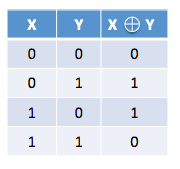
Table 1. XOR (exclusive-or) operations
The simplest form of erasure coding is based on XOR (exclusive-or) operations, shown in Table 1. XOR operations are associative, meaning that X ⊕ Y ⊕ Z = (X ⊕ Y) ⊕ Z. This means that XOR can generate 1 parity bit from an arbitrary number of data bits. For example, 1 ⊕ 0 ⊕ 1 ⊕ 1 = 1. When the third bit is lost, it can be recovered by XORing the remaining data bits {1, 0, 1} and the parity bit 1. While XOR can take any number of data cells as input, it is very limited since it can only produce at most one parity cell. So, XOR encoding with group size n can tolerate up to 1 failure with an efficiency of n-1/n (n-1 data cells for a group of n total cells), but is insufficient for systems like HDFS which need to tolerate multiple failures.
This limitation is addressed by Reed-Solomon (RS), another form of EC. RS uses sophisticated linear algebra operations to generate multiple parity cells, and thus can tolerate multiple failures per group. This makes it a common choice for production storage systems. RS is configurable with two parameters, k and m. As illustrated in Figure 1, RS(k,m) works by multiplying a vector of k data cells with a Generator Matrix (GT) to generate an extended codeword vector with k data cells and m parity cells. Storage failures can be recovered by multiplying the surviving cells in the codeword with the inverse of GT—as long as k out of (k + m) cells are available. (Rows in GT corresponding to failed units should be deleted before taking its inverse.) This means that the group can tolerate the failure of any m cells.
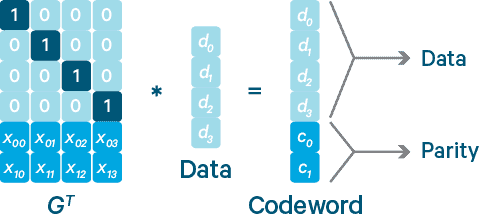
Figure 1: Reed-Solomon encoding with four data units and two parity units (source)
With Reed-Solomon, the user can flexibly adjust data durability and storage cost by choosing different values for k and m. The number of parity cells (m) determines the number of simultaneous storage failures that can be tolerated. The ratio of data cells to parity cells determines the storage efficiency:
Typical RS configurations such as RS (6,3) and RS (10,4) provide superior data durability and superior storage efficiency compared to three-way replication, since they can tolerate up to three or four failures respectively and do so with <50% storage overhead. Table 2 compares the fault tolerance and storage efficiency of replication, XOR, and RS with typical parameters.
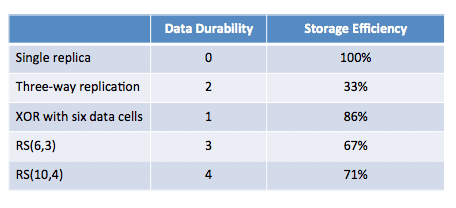
Table 2: Comparison of replication, XOR, and RS in fault tolerance and storage efficiency
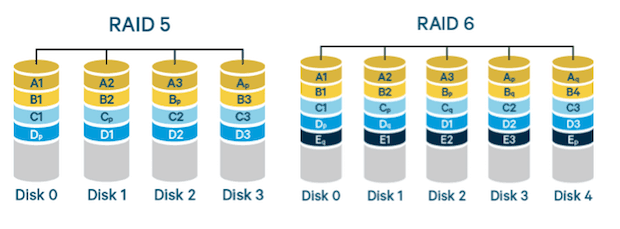
Figure 2. RAID-5 and RAID-6 illustrations (source)
EC has long been used in local storage systems, notably in the forms of RAID-5 and RAID-6. RAID-5 typically uses XOR encoding since it only needs to tolerate a single disk failure, while RAID-6 uses Reed-Solomon with two parity cells to tolerate up to two failures. The cell size is typically configurable, with the erasure coding groups formed by the cells at the same offset on each disk.
EC in Distributed Storage Systems
To manage potentially very large files, distributed storage systems usually divide files into fixed-size logical byte ranges called logical blocks. These logical blocks are then mapped to storage blocks on the cluster, which reflect the physical layout of data on the cluster.
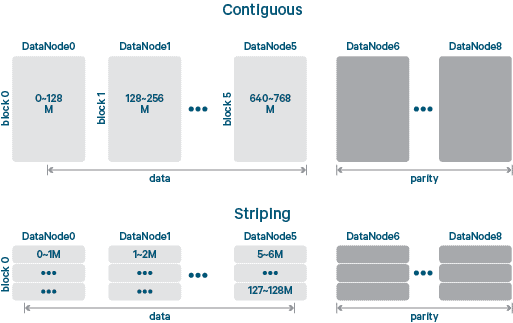
Figure 3. Illustration of EC with contiguous and striped layouts
The simplest mapping between logical and storage blocks is a contiguous block layout, which maps each logical block one-to-one to a storage block. Reading a file with a contiguous block layout is as easy as reading each storage block linearly in sequence.
In contrast, a striped block layout breaks a logical block into much smaller storage units, typically called cells, and writes repeated stripes of cells round robin across a set of storage blocks. Reading a file with a striped layout requires querying the set of storage blocks of a logical block, then reading stripes of cells from the set of storage blocks. This section discusses how EC can be supported on both block layouts.
In principle, block layout (contiguous vs. striped) and redundancy form (replication vs. EC) are two orthogonal dimensions, resulting in four possible combinations. As surveyed in Figure 4, they are all in active use by major storage systems. Some systems, including Ceph and QFS, support configuring layout and/or redundancy on a per-directory or per-file basis.
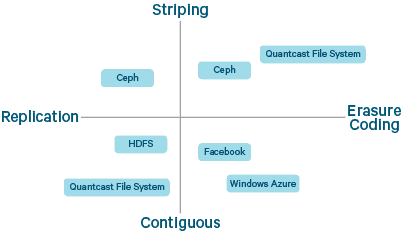
Figure 4. Spectrum of existing distributed storage systems with different block layouts and redundancy forms
As discussed before, erasure coding is advantageous over replication in terms of storage efficiency. However, this comes at the cost of additional complexity and more expensive failure recovery.
Along the block layout dimension, striping can provide better I/O throughput than a contiguous layout since it can utilize multiple spindles in parallel. However, the implication is that most reads will be remote, stressing the need for fast full-bisection networks. This approach contradicts the traditional MapReduce paradigm of scheduling for data locality, though it is still possible if applications read and write their data with awareness of the underlying cell and stripe sizes.
Design and Implementation
Choosing Block Layout
For HDFS-EC, the foremost question was determining which block layout was most suitable. A contiguous layout is simpler to implement since the read and write path would still be very similar to the current system with replication. However, it is only suitable when files are quite large, since the full cost savings are only realized when writing full stripes. For instance, with RS (10,4) a stripe with only a single 128MB data block would still end up writing four 128MB parity blocks, for a storage overhead of 400% (worse than 3-way replication). A contiguous layout is also only suitable for offline or background EC, since otherwise a client would need to buffer GBs of data blocks to calculate parity.
On the other hand, EC with striped layout can realize storage savings with both small and large files because the cell size is much smaller (typically 64KB or 1MB). This overall smaller group size also enables online EC where clients directly write erasure coded data, since only a few megabytes of buffering are needed to calculate parity information. One drawback is that some locality-sensitive workloads will have suboptimal performance when running on striped blocks. To better serve such workloads, a striped file can be converted to the contiguous layout, but that requires almost rewriting the entire file.
Based on this analysis, file size is the key determining factor. If cluster usage is dominated by large files—meaning six or more 128MB blocks, enough for a full EC group under RS(6,3) scheme—then a contiguous layout is suitable since we can avoid the implementation issues of combining blocks from multiple small files into a single group. However, if cluster capacity is dominated by small files, then a striped layout is the more natural choice to achieve better cost savings and administration.
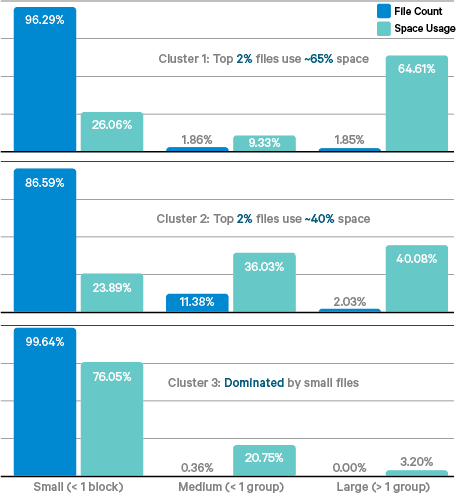
Figure 5. File-size histograms from production clusters
We conducted an empirical study of the HDFS file-size distribution at three of Cloudera’s largest customers. Details of the analysis can be found in our report, and Figure 5 summarizes the key findings. Most importantly, usage by small files (less than one group) varied between 36-97% of all cluster usage, indicating that handling small files is very important.
Based on this finding, we dedicated the first phase of HDFS-EC to supporting EC with striped layout.
Generalizing the Block Concept on NameNode
A major portion of this project is dedicated to generalizing the fundamental Block concept to support data striping. The assumption of contiguous block layout is widely and deeply embedded in HDFS internal logic. To support the striped layout, the concept of a logical block had to be separated from that of a storage block. The former represents a logical byte range in a file, while the latter is the basic unit of data chunks stored on a DataNode. Figure 6 demonstrates the concepts of logical and storage blocks. In the example, the file /tmp/foo is logically divided into 13 striping cells (cell_0 through cell_12). Logical block 0 represents the logical byte range of cells 0~8, and logical block 1 represents cells 9~12. Cells 0, 3, 6 form a storage block, which will be stored as a single chunk of data on a DataNode. For conciseness the figure doesn’t include parity blocks/cells.
A naive mechanism to support this generalization is for the HDFS NameNode to monitor each storage block in its blocks map, which maps from a block ID to the corresponding block, and then use another map to go from a logical block to its member storage blocks. However, this means small files will incur significant memory overhead on the NameNode because striping results in many more storage blocks than replication.
To reduce this overhead we have introduced a new hierarchical block naming protocol. Currently HDFS allocates block IDs sequentially based on block creation time. This protocol instead divides each block ID into 2~3 sections, as illustrated in Figure 7. Each block ID starts with a flag indicating its layout (contiguous=0, striped=1). For striped blocks, the rest of the ID consists of two parts: the middle section with ID of the logical block and the tail section representing the index of a storage block in the logical block. This allows the NameNode to manage a logical block as a summary of its storage blocks. Storage block IDs can be mapped to their logical block by masking the index; this is required when the NameNode processes DataNode block reports.
We have simulated the NameNode memory usage with EC based on the three HDFS cluster images in Figure 5. Results show that without the new hierarchical block naming protocol, striping would increase the size of NameNode blocks map by 250%~440%. With the protocol, striping only increases the NameNode blocks map by 21%~76%. More details of the memory overhead analysis can be found in this report.
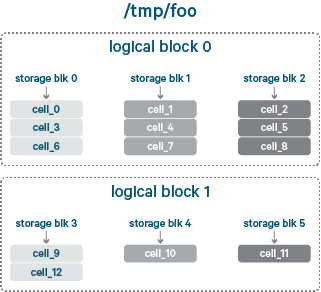
Figure 6. Logical and storage blocks
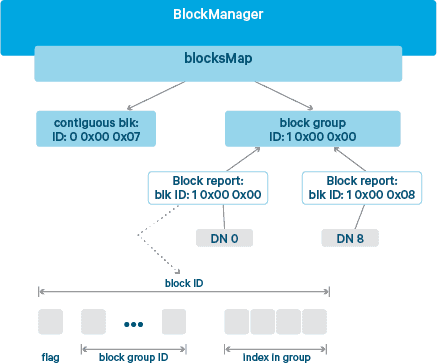
Figure 7. Hierarchical block naming protocol
Because of this design, a logical block appears as a group of internal storage blocks on NameNode. Table 3 summarizes terminologies related to striping and EC blocks. The default EC policy is to use 6 data blocks and 3 parity blocks, and a striping cell size of 64KB. These default values were selected based on typical cluster and file sizes. A wider EC schema, such as the (10,4) setting in Facebook’s EC implementation of HDFS-RAID, has better storage efficiency but leads to more expensive recovery, as well as placing a high requirement on the number of racks in the cluster.
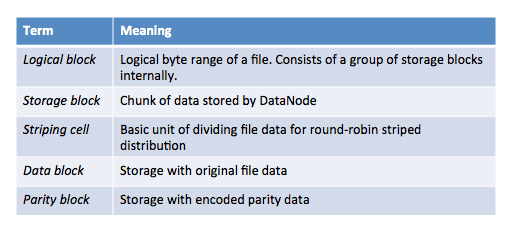
Table 3. Glossary of EC block concepts
Supporting the logical block abstraction required updating many parts of the NameNode. As one example, HDFS attempts to replicate under-replicated blocks based on the risk of data loss. Previously, the algorithm simply considered the number of remaining replicas, but has been generalized to also incorporate information from the EC schema. Other key changes include updating quota, fsck, balancer, and so forth.
Client Extensions
The main I/O logic of the HDFS client is implemented in DFSInputStream and DFSOutputStream. We have extended them into DFSStripedInputStream and DFSStripedOutputStream with data striping and EC support. The basic principle behind the extensions is to allow the client node to work on multiple storage blocks in a logical block in parallel. When used together with HDFS encryption, these extensions operate on encrypted data—i.e., below the encryption layer.
On the output/write path, DFSStripedOutputStream manages a set of data streamers, one for each DataNode storing an internal storage block in the current logical block. The streamers mostly work asynchronously. A coordinator takes charge of operations on the entire logical block, including ending the current logical block, allocating a new logical block, and so forth.
On the input/read path, DFSStripedInputStream translates a requested logical byte range of data as ranges into internal storage blocks stored on DataNodes. It then issues read requests in parallel. Upon failures, it issues additional read requests for decoding.
DataNode Extensions
To avoid the chance of expensive foreground data reconstruction on the client side, it is critical to identify and fix DataNode failures in the background. As with replication, the NameNode is responsible for tracking missing blocks in an EC stripe and assigning recovery work to DataNodes. The recovery work on the DataNode is handled by a new ErasureCodingWorker (ECWorker) component, which does the following to reconstruct a missing EC block:
- Read the data from source nodes: A dedicated thread pool, initialized at
ErasureCodingWorkerstart time, is used to read data blocks from different source nodes. Base on the EC schema, it schedules the read requests to all source targets and ensures only to read minimum required input blocks for reconstruction.
- Decode the data and generate the output data: Similar to EC client, ECWorker finishes decoding/encoding work by using the codec framework that will be introduced in the Erasure Codec Framework.
- Transfer the generated data blocks to target nodes: Once decoding is finished, it will encapsulate the output data to packets and send them to target DataNodes.
Codec Calculation Framework
Data encoding/decoding is very CPU intensive and can be a major overhead when using erasure coding. To mitigate this in HDFS-EC, we leverage Intel’s open-source Intelligent Storage Acceleration Library (Intel ISA-L), which accelerates EC-related linear algebra calculations by exploiting advanced hardware instruction sets like SSE, AVX, and AVX2. ISA-L supports all major operating systems, including Linux and Windows.
In HDFS-EC we implemented the Reed-Solomon algorithm in two forms: one based on ISA-L and another in pure Java (suitable for systems without the required CPU models). We have compared the performance of these two implementations, as well as the coder from Facebook’s HDFS-RAID implementation. A (6,3) schema is used in all tests in this section.
Figure 8 first shows results from an in-memory encoding/decoding micro benchmark. The ISA-L implementation outperforms the HDFS-EC Java implementation by more than 4x, and the Facebook HDFS-RAID coder by ~20x. Based on the results, we strongly recommend the ISA-L accelerated implementation for all production deployments.
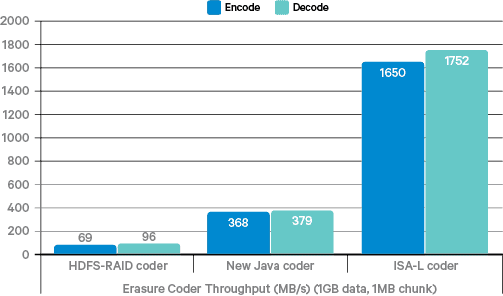
Figure 8. Encoding and decoding performance comparison
We also compared end-to-end HDFS I/O performance with these different coders against HDFS’s default scheme of three-way replication. The tests were performed on a cluster with 11 nodes (1 NameNode, 9 DataNodes, 1 client node) interconnected with 10 GigE network. Figure 9 shows the throughput results of 1) client writing a 12GB file to HDFS; and 2) client reading a 12GB file from HDFS. In the reading tests we manually killed two DataNodes so the results include decoding overhead.
As shown in Figure 9, in both sequential write and read and read benchmarks, throughput is greatly constrained by the pure Java coders (HDFS-RAID and our own implementation). The ISA-L implementation is much faster than the pure Java coders because of its excellent CPU efficiency. It also outperforms replication by 2-3x because the striped layout allows the client to perform I/O with multiple DataNodes in parallel, leveraging the aggregate bandwidth of their disk drives. We have also tested read performance without any DataNode failure: HDFS-EC is roughly 5x faster than three-way replication.
Note that further performance gains should be possible. With an RS (6,3) layout, a striped layout should be able to achieve approximately a 6x improvement in I/O throughput, or approximately 1GB/s of throughput. The current performance does not meet the theoretical optimum partially because the striped layout spreads logically sequential I/O requests to multiple DataNodes, potentially degrading sequential I/O pattern on local disk drives. We plan to add more advanced prefetching and write buffering to the client as a future optimization.
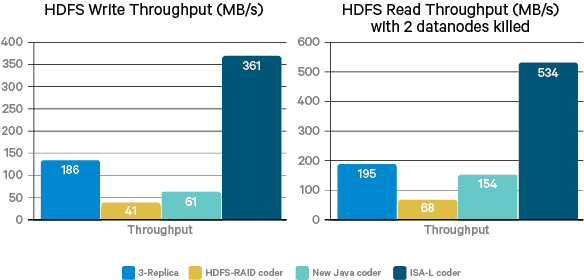
Figure 9. HDFS I/O performance comparison
Another important optimization in ISA-L is support for incremental coding. This means applications do not have to wait for all source data before starting the coding process. This will potentially enable HDFS-EC to efficiently handle slow writing applications, as well as append operations.
Future Work
This article summarizes the first development phase for HDFS-EC. Many exciting extensions and optimizations have been identified and documented under HDFS-8031. A major follow-on task is to build a generic EC policy framework which allows system users to deploy and configure multiple coding schemas such as conventional Reed-Solomon, HitchHiker, LRC, and so forth. By abstracting and modularizing common codec logics, the framework will also enable users to easily develop new EC algorithms. We also plan to further optimize NameNode memory consumption and reduce data reconstruction latency.
To save storage space on files belonging to locality-sensitive workloads, we have established HDFS-EC phase II (HDFS-8030) to support EC with contiguous block layout.
Conclusion
Erasure coding can reduce the storage overhead of HDFS by approximately 50% compared to replication while maintaining the same durability guarantees. This results in a substantial storage-cost savings in hardware expenditure, since users can now store twice as much data on the same amount of raw storage.
Implementing HDFS-EC required making improvements across many parts of HDFS and the collaborative efforts of developers at Cloudera, Intel, and the rest of the Apache Hadoop community. The design of HDFS-EC results in minimal additional overhead on the NameNode through the use of a new hierarchical block naming protocol, and also leverages the optimized Reed-Solomon routines in Intel ISA-L for high-performance encoding and decoding of parity information.
Note: Zhe Zhang and Weihua Jiang (Intel) will lead a technical session about HDFS-EC at Strata + Hadoop World NYC 2o15, on Weds. Sept 30 at 2:55pm.
Andrew Wang (Hadoop PMC) and Zhe Zhang are Software Engineers at Cloudera.
Kai Zheng and Uma Maheswara G. (Hadoop PMC) are Software Engineers at Intel.
Vinayakumar B. (Hadoop PMC) is a Software Engineer at Huawei; previously, he worked at Intel.




I want to know how this performance test experiment is done. Hope it helps.